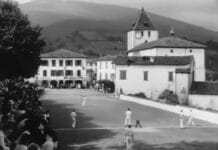Over the past ten years that we’ve been blogging, we’ve had many questions about the origin of the most famous Basque symbols from people who wanted to know more about where the symbols they love and which they feel represented by had come from.
It’s also true that we’ve received many claims and dire comments that tried to make us understand that these symbols had no value whatsoever.
For example, many have claimed that they’re “made up”. It’s hard to explain to someone who tells us that the ikurriña is nothing more than a 19th-century invention that all flags are inventions and none have just popped into existence, or that the ikurriña is a symbol that is far older than many of the flags that now fly at the UN Plaza, no doubt about it. It’s not that it’s hard to understand; it’s just that most of these people are not interested in knowing the truth.
A nation’s symbols are born when the nation needs them. And they were all born after the end of the 18th century, with the consolidation of the idea of the nation-state and the substitution of the idea that the kings owned their subjects and territories to the idea of a nation as a community of citizens, all of whom had the same rights and obligations.
The only case that might break out of that general historical mold could be the Helventian Confederation, which has had the same flag since at least the 14th century. That might be due to the fact that that is when they finally, definitively, broke free of the yoke of kings and emperors (we’re jealous).
What can you say to those who proclaim that the ikurriña was first the flag of a political party, or that it was a copy of the Union Jack (which, by the way, was created in 1801)? Ignorance is a poor field for ideas to grown in, but it’s an amazing place for lies and deceit to thrive in.
We’ve been thinking that it was going to be necessary to write about this topic for a long time. It’s true that we’re not bringing you Basque-related news items from around the world. But we’ve gotten so many comments and questions that we believed it was worth it to include it.


This was a topic that we came across in a small pamphlet the Sabino Arana Foundation published a while back, which matched perfectly with the goal we were trying to fulfill: explain the origin of three key symbols for any nation, the flag, the coat of arms, and the anthem, clearly and easily.
So we decided to update it slightly, including, for example, a representation of the evolution of the ikurriña from its original idea as the flag of Biscay inside the Basque Confederation (made up of all the territories, confederated like free and equal brothers) to its modern representation of the whole country. In this first outline of flags, each one of the six territories had its own “ikurriña” and there was one which represented the whole nation.
We hope that this will be useful for those who want to know a bit more about the symbols they feel represented by, and that it will help the other group as well, those who are willing to live in ignorance in order to not have to accept their value, to learn something.
Last Updated on Dec 20, 2020 by About Basque Country






























